Monday, February 22, 2016
Denervation Tx Helps Patients With Discogenic Back Pain
Google Compare Will Sunset In March
Please visit Marketing Land for the full article.
Lee Odden Educates B2B Marketers on SEO for Content Marketing

As content marketing professionals, most of us would consider SEO a highly technical domain. Best leave that to the real nerds, right? Wrong. Google, Bing and all the other search engines have significantly altered their algorithms in the pastfew years. And these changes continue to favor the highest quality content, often rewarding smart content marketers with first position rankings.
With a bit of SEO sweet sauce, your content marketing sandwich will taste much better to search engines, and users too.Below, I will explore 4 major themes from TopRank Marketing CEO,Lee Oddens recent Content2Conversion talk on SEO for Content Marketers, including:
- The State of SEO in 2016
- Understanding Self-Directed Buyer Behavior
- How to, Be The Best Answer
- How to Create Smarter Integrated SEO Content for The Web
First things First: Optimizing for Users
Lets start by getting one thing straight about optimization. As content marketers, we shouldnt be optimizing our content for search engines. As Lee often points out, Google doesnt pay the bills. Your buyers pay the bills. Therefore, optimize for users, not search engines.
Old SEO rules would have you stuffing websites with keywords, creating thousands of new pages, tagging YouTube videos with every keyword you can get your hands on, and hoping something sticks. We give you permission to stop doing most, if not all of those things.
Part I: The State of SEO in 2016
So, how are most content marketers utilizing SEO in 2016? And more importantly, does SEO even matter anymore? Yes it matters. But content marketers and even many SEOs are failing to take advantage of recent algorithm changes. So, heres a snapshot from the front lines of the industry on what most content marketers actually dowith SEO:

- Implement more than 1-2 tactics (10-20%).
- Perform Tech SEO Audit (Maybe).
- Make a list of keywords.
- Use keywords in titles, links, copy etc.
- Share on social and wish for links.
- Review monthly rankings reports
The problem with the list above is it looks a lot like 2010. Things have changed, and you should too.
Can Tools Automate your SEO?
At TopRank Marketing, we get asked about tools all the time. With all the tools, plugins and software available, its easy to believe that SEO is an automated function. Its not. In fact, as Googles algorithms become more complicated, it can be increasingly difficult to optimize your content.
According to the most recent LinkedIn data, SEO and SEM ranks 4th among top skills companies seek (below).

What this research doesnt uncover is content marketers and SEOs are adopting an increasingly hybrid skillset. This is largely due to the fact that search engines now require higher quality content and a variety of content types, in order for content efforts to be most effective.
Hummingbirds the Word
Starting in 2013, an algorithm update was rolled out from Google, dubbed Hummingbird. This algorithm completely replaced the original Google algorithm, fundamentally changing the nature of how search engines crawl and rank web content. All you need to know is content quality, a variety of content types, and social media are all more important than ever.
Advice From The Front Lines
But dont take it from us. Here are what some much smarter folks have to say about how SEO fits into their overall marketing in 2016:

SEO is a foundational element of digital marketing Alison Herzog, Director Global Social Business & Digital Strategy, Dell

As long as theres Google, SEO will be a staple in digital marketing. Barbara Feinberg, Senior Product Marketing, McKesson
Part II: Understanding Buyer-Directed Behavior
The first step to understanding your buyers is to accept that they are self-directed. Theyll go to Google, social media, their LinkedIn network, friends, or pick up the phone and ask for a reference long before they contact you, or consume any of your content. Understanding the nature of B2B self-directed buyers is crucial to the success of any SEO efforts tied to your content marketing.
And in 2016, all of your potential customers are self-directed. According to Pardot, 70% of the buyers journey is complete before a buyer ever reaches out to sales. Which is why developing fruitful relationships between your marketing and sales department is fundamental to the success of your content marketing.
A common mistake among B2B marketers is someone from sales will reach out to a self-directed buyer, completely unaware that this buyer may have already started their journey. The sales professional (or targeted content in many cases) often treats them like they know nothing, or misses the delivers the wrong message to the prospect, based on where they are at in their journey. Say goodbye to that lead!
Take a cue from Gartner, who has done some fascinating research on this topic. They uncovered that more than 60% of all buyers indicated they prefer a self-driven informational search at the exploration, evaluation, and engagement phase of their purchase cycle (see below).

The bottom line is your customer wants to be in the drivers seat. They dont want a sales pitch. They want information. They dont want your opinion. They want a third-party opinion of your product or service. They want information from Google, Bing, YouTube, industry reports, and third-party validations.
Think about things from their point of view. They dont know who to trust, what to believe, or who is trying to screw them over.So, what are your options? Be the best answer. Be a conduit for the information. Curate your third-party verifications, peer reviews, social media posts and other relevant content.
So at this point, you might be asking yourself, What does this have to do with SEO and content? Fair question. Searc engine queries are an explicit indication of intent. And tapping into the needs, intentions, and desires of your search audience will give you a solid map for the length, type, and style of content you must produce to meet your B2B audiences needs.
Part III: How to Be The Best Answer
So, weve covered the state of SEO in 2016, weve accepted that our buyers are self-directed, and now we just need to create all that killer content that will make them fall in love with our brand. No pressure, right? Lets start by examining the following marketing funnel. Its a solid example of what NOT to do.

Instead of creating more useless content and barraging your leads with information, you should try to be the best answer in search engine results. Why? Because, by 2020 the world will have nearly 50 billion internet-connected devices. In addition, a full 90% of the worlds information has been created in the last 2 years alone. The bottom line is your prospects are overwhelmed.
The B2B Buyer Journey & Search
Before you can create content for your buyers, youll need to understand where search engines fit into your buyers journey. Start by talking to your customers. Ask them how they found out about you. Ask them what made them want to work with you, or buy your product. If your buyers are socially active, run a Twitter poll. If necessary, conduct some research to find out more about your audience. Most importantly, find out what types of content they are looking for via search engines, and where this fits in their journey.
Consider how many steps are on the following sample buyers journey, and how search engines and social media feed into nearly every step:
- They see your brand or meet a salesperson at an event
- They view the brand on Twitter or LinkedIn
- They run a Google search for the company
- Connect with someone on LinkedIn
- Subscribe to company newsletter
- Receive e-mail follow up from sales
- Google search sales professional
- Google search company
- Search the solutions and topic
- Download a guide via newsletter CTA
- Do in-depth topical Google search based on your guide
- They search for competitors
- They receive nurture messaging and emails
- The contact company for a demo
- They evaluate options
- They search for product or company reviews
- They make a decision
Granted, this list is a bit aggressive. Nonetheless, it illustrates the potential complexity of your buyers purchase process, and where search engines come in and out of the process.
Your Buyers are Complex, Are You?
Maybe you look at the list above and you think, Yeah I already know all that. Great. Maybe youve already identified the B2B content marketing tactic necessary to communicate with folks at different stages of their journey. Again, thats awesome. But, are these tactics integrated?
Lee often emphasizes the fact that content marketing efforts are rarely integrated. We find the most challenging aspect of content marketing is to plan for the ecosystem. Not just an infographic, or a one-off whitepaper, or a blog post. Rather, how do all of these channels and systems integrate? Thats where you really begin to be the best answer for your B2B audience. Consider the following chart, which displays the most common B2B content marketing tactics:

On the surface, it looks like B2B marketers are using a variety of tactics. But when you consider that 65% of B2B buyers think vendors should, Curb their sales messaging, you start to wonder if this chart represents an over-usage of a variety of channels to barrage buyers with sales messaging.
How to Become the Best Integrated Search Engine Answer

Certain styles, flavors and tactics make sense in each potential customer touch-point. A LinkedIn connection message should not feel like an auto-generated corporate email. Likewise, an infographic shouldnt contain so much text that your buyers want to barf. Most of all, use common sense. Without further ado, the following is a checklist of tactics that will ensure you are the best, most integrated answer for your buyers in your content marketing and SEO efforts:
- Create a constellation of ideas that makes you the BEST answer (see above)
- Write title tags that inspire clicks
- Go deep: provide comprehensive content on specific topics
- Engage your networks for social sharing
- Optimize for Google AND people
- Mobile SEO is a must
- Think about attraction AND promotion. Use paid, organic, and media relations to amplify your efforts
- Always be customer- centric
- Integrate and optimize
- Go in-depth (not just length) & be uber-relevant
- Do your research: if someone else has covered the topic, know about it and raise the bar
If you need TopRank Marketings helpto become the best answer for your customers, contact us today for a free consultation.
![]()
Gain a competitive advantage by subscribing to the
TopRank Online Marketing Newsletter.
Online Marketing Blog - TopRank, 2016. |
Lee Odden Educates B2B Marketers on SEO for Content Marketing | http://www.toprankblog.com
The post Lee Odden Educates B2B Marketers on SEO for Content Marketing appeared first on Online Marketing Blog - TopRank.
How Organizations are Leveraging Content Across the Buyer Journey
When you hear the word content in a business context, you probably automatically associate it with marketing.
As a tactic, content marketing has been around for hundreds of years, while the term content marketing has only surged into popularity (and regular marketing lexicon) in the past 6-7 years. And it shows no sign of slowing down in 2016, 88% of organizations claim to be using content marketing as a key B2B marketing tactic.
The undeniable popularity and widespread usage of content marketing points to the effectiveness of content. However, content isnt only effective in the strict marketing sense content satisfies the entire buyer journey, from awareness, to engagement, to lead generation, to sales enablement, and even to customer success.
Consequently, the way we think about content is changing: content no longer lives exclusively in the marketers domain. In fact, content is the lifeblood of your entire organization.
Content in every corner
Content certainly starts with marketing, playing important roles in generating awareness, engagement, and of course, leads. But this is only the start of the buyer journey.
As a lead converts to an opportunity and enters the sales realm, content can (and should) be leveraged by sales teams to handle objections, build relationships, and target key accounts. Building a content library for sales enablement is a powerful way to educate and nurture potential customers, clarify value proposition, execute account-based marketing tactics, and ultimately, expedite the sales cycle.
Content plays an equally important role once the prospect has converted into a customer. Your customer support or success team can (and should) leverage content to coach and empower your customers. Building a knowledge base or resource center with product-centric content improves customer marketing effectiveness by allowing the nurturing process to be continued even further. Filling your knowledge base with bottom-of-the-funnel content that enables customer self-service will increase your success teams productivity and, more importantly, improve your customer retention rates.
Why content isnt enough
Understanding why and how content satisfies the entire buyer journey is the easy part, and creating content to better satisfy the journey is an important first step.
Simply creating the content, however, isnt enough. Organizations must be able to easily leverage this content for more than one purpose and one campaign in order to satisfy the buyer journey. This is where marketing automation comes into play content fuels lead nurturing campaigns and helps build up your lead data based on conversions.
But as much as your marketing automation platform can help you deliver the right content to the right person, it cant help you deliver the right content experience for the end user (be it a reader, a prospect, or a customer).
What do I mean by this? Well, your content experience is the place where all the user action takes place. It's the destination that you send your prospects to. It's where your visitors consume your content, where they convert to a lead, and where you can measure how effective your content is at every stage of the journey.
Sending your end user (regardless of where theyre at in the buyer journey) to a non-contextual, generic blog or resource center wont help them find the information they need to move further down the funnel, and it certainly wont compel them to continue their content journey. Your content will be far more effective if youre able to send the end user on a tailored engagement path.
Delivering a well-optimized content experience
Lets take a look at this in action.
Your marketing team produces an eBook. They can leverage this eBook for lead generation, targeting the particular buyer persona for whom they created the eBook using marketing automation and paid promotion tactics. Adding this eBook to your internal library for sales enablement, your sales team can leverage it to speak to a particular pain point that one of their prospects is experiencing. Or, similarly, your customer success team could also leverage this eBook in their knowledge base to provide more high-level information for your customers.
Those are three different use cases from just one eBook, within one organization. Each use case has different end goals and requires different context.
So, how do you optimize the content experience for each?
Tailor the experience Ensure your content is targeted, personalized, and strategically organized for the particular use case. For instance, if its an advanced-level eBook, dont include a CTA to sign up for a beginner-level webinar.
Facilitate further content discoverability Dont let your content pile up by date, or by type of content. Regardless of the use case, people are much more likely to search for a specific answer than they are to search for a white paper.
Include targeted and contextual CTAs Provide a logical and contextual next step to continue the buyer journey.
Conclusion
Content begins with marketing generating awareness, engagement, and leads but it also feeds into sales enablement and customer success, fueling your entire organization and propelling your end users throughout the entire buyer journey.
However, organizations must think beyond individual content assets and start producing relevant and contextual content experiences for the desired end user. By leveraging content experiences at every stage of the buyer journey, your content will not only become more valuable to your end users, but also to your organization.
Content can do a lot of things for your organization, but not if you don't start thinking about it in a larger context. Download theModern Marketing Essentials Guide to Content Marketingand start thinking. And doing.
8 Tools That Will Help You Get Inside Your Readers Heads

Do you hate the phrase getting inside your readers head?
Althoughyou know you are supposed to be able to do it, you dont haveany specific instructions onhow to do it.
Of course, its important to understand your currentreaders and those you are trying to attract with your content, but thats one of the hardest skills you have to develop as a writer.
Its going to take years of continuous improvement to become really good at it.
However, there are ways for you to get thisinformation much soonernamely, formulas and tools.
In this post, Im going to focus on the latter.
Ive put together a list of the eight best tools for getting inside your readers heads.
They will give you tangible data you can use to produce content that resonates with your readers.
Finally, Ill show you how to use the key features of these tools. I promise that none of them are difficult to use and that they are worth your time.
Tool type #1 Hard demographics data
If you want to know what your readers think, you first need to know who they are.
Thats where demographics come in.
Essentially, any statistic that describes a characteristic of your audience is a demographic. The most common are:
- age
- location
- device preference
- gender
- marital status
The tools in this section will help you figure out who you should be targeting in the first place. They can be used whether you have an existing audience or are just starting off.
1. Demographics Pro for Hootsuite
This tool is one of the most complete Ive ever come across when it comes to demographics.
The only significant limitation is that it draws its data from Twitter.
However, as long as people in your niche use Twitter (which is likely), its really useful.
While you can sign up for Demographics Pro directly, its pretty simple to use this Hootsuite app.
When you click the link in the title for this tool and then click the Install App button on the page, youll be taken to Hootsuite, where youll see a pop-up like this (if youre signed in):

Once you install the app, youll see a new tab on your account called Demographics Pro for Twitter.

To use the tool, simply enter a Twitter handle (e.g., @NeilPatel), and click get profile.
Thatll automatically bring up some basic data:

More useful, though, is the view full profile option. Click that link, and youll see an extremely detailed panel like this:
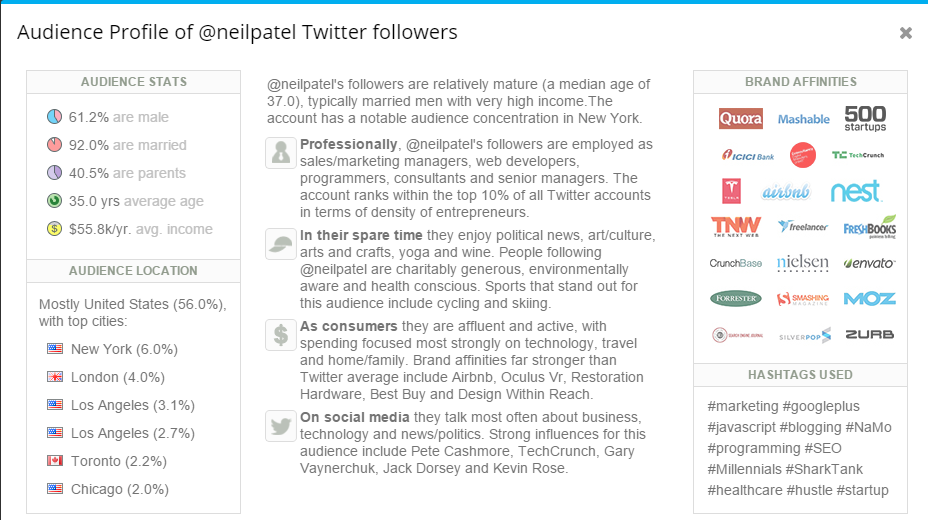
From this, you can get a ton of demographic information about your (or their) followers and even some psychographics (more on that in section 2):
- gender distribution
- marital status
- parental status
- age
- average income
- location
- types of jobs they have
- types of hobbies they have
- types of brands they like
Its a gold mine of information.
If youre already using Twitter, start with your own profile.
Then, get the stats of some of your top competitors. If you dont know who they are, head to Buzzsumos amplification tool, and search for some keywords that describe your niche:
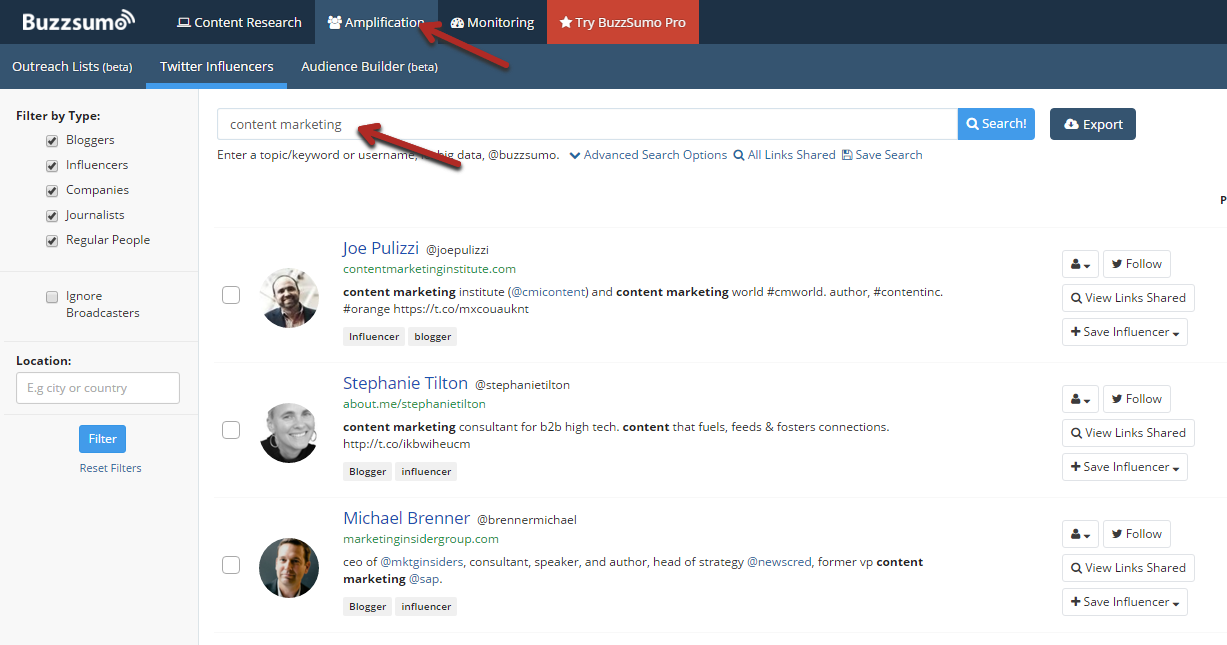
2. Sprout Social
This is a similar type of social audience analyzer. However, it analyzes both Facebook and Twitter, so theres a potential to get a few different insights.
Once you sign up for an account (free trials available), you can connect your Twitter and Facebook accounts (only your own).
That will populate your account with a bunch of social trends data, but more importantlydemographics.

On top of getting a gender distribution of the audience on each platform, you get a detailed breakdown of their age brackets. Thats another important insight into your audience that will come in andy.
3. Google Display Planner
It might surprise you to find out that the Google Display Planner is another decent source ofdemographic dataeven though itisnt the tools primary purpose.
When you open the planner, you have two options for searching:
- keywords, topics, or sites
- a landing page
I recommend doing both, and several times if possible. The larger your sample size, the more accurate your demographics data will be.
You can enter your own site, a competitors site, orkeywords that you will be targeting with SEO.
Once youve picked an option, click the blue button to proceed:
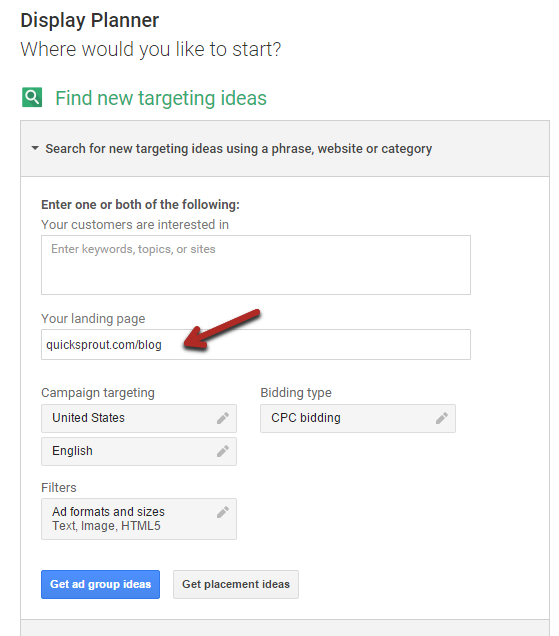
On the next page, youll get a whole bunch of suggestions for ad keywords. Ignore them.
The only thing we care about here is the panel in the center of the screen that breaks down the demographics of people who search for the terms you entered (or terms found on the page you entered).
It looks like this:

Again, you get a gender and age breakdown.
Additionally, you can record which devices that audience prefers to use.
Is all this information redundant? It is to a degree, but its still useful. By now, you have demographic data from three different tools.
That data may look the same, but there may be differences because its collected from different sources.
Having data from multiple sources ensures that it wont be skewed. You can take an average of all the data you collect or keep it as a range (i.e., average age might be 25-34 and not just one specific number).
4. FollowerWonk
The final tool in this section also uses Twitter to retrievedemographic data. However, it provides one important feature that the others miss.
Once you create an account, go to the Analyze tab on the top menu. Enter your Twitter handle, and let the tool scan your followers.
On the next page, look for a graph like the one below that shows at what times your followers are most active.
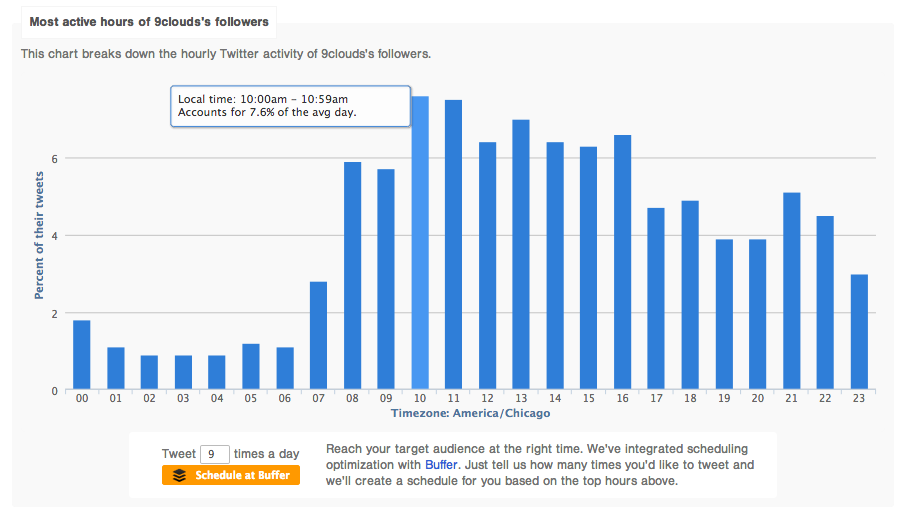
This information will be useful when you are promoting your content, especially on social media.
Tool type #2 Understand your readers thinking (psychographics)
Once youve nailed down who your readers are or will be, its time to start figuring out how they think.
Ideally, you want to answer questions such as:
- what are their biggest problems?
- what type of content do they like the most?
- what kind of language do they use?
- what bores them, and what excites them?
The tools in this section will help you answer these questions and eliminateguesswork.
5. Faqfox
This is a simple tool that makes getting useful data from forums easy.
Basically, you enter a keyword and sites to scan, and the tool pulls up relevant thread titles for you. You can search multiple sites at once.
Start by inputting a keyword into the first field. You could manually enter sites, but an easier option is to simply pick one of the preset categories. If youre not sure which one to choose, pick generic:
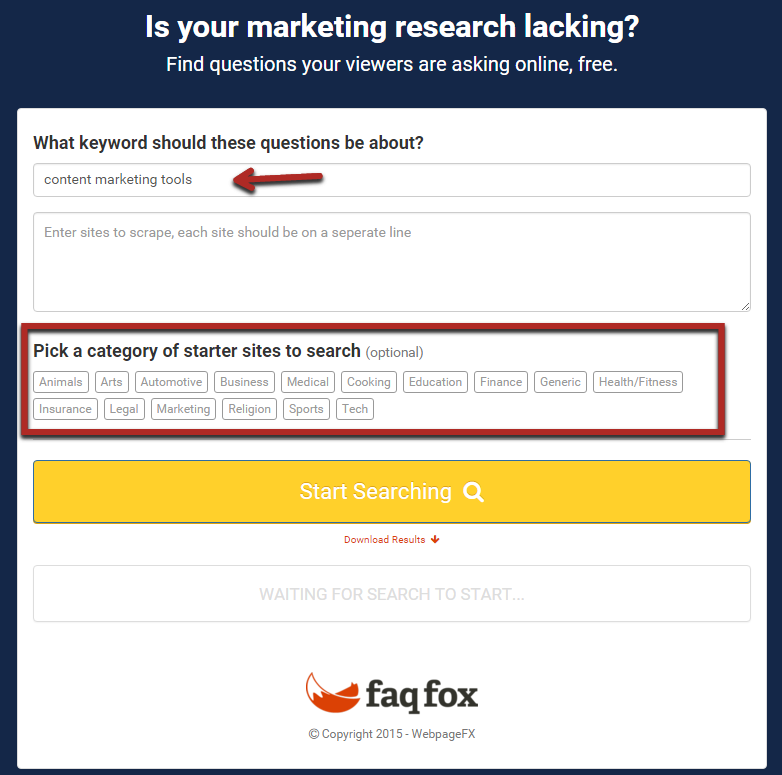
The tool will load the results after a few seconds of search:

I recommend downloading the results into a spreadsheet and analyzing them there.
Remember those questions you need to answer? These results will help you do that.
Youll have some irrelevant results, so start by removing those.
Once you have a few hundred relevant threads left, dig in.
Note down:
- common questions (those thatcome up more than once)
- any phrasing that you wouldnt normally use yourself
- any other keywords that you havent thought of (that you see in the titles)
Then, repeat this whole process at least a few times with different keywords.
6. Crazy Egg
If you know me well, you know I founded Crazy Egg.
Ill let you judge the tool for yourself, but it can be incredibly useful for understanding the behavior of your readers.
The one catch is that you have to actually have readers before you can use the tool.
Assuming you do, Crazy Egg will give you a variety of heatmaps that will show you exactly how readers interact with your content.
There are two types of maps youll want to look at.
First is the scroll map, which tells you how people scroll through your page. You can tell what portions of the page they pay more or less attention to.
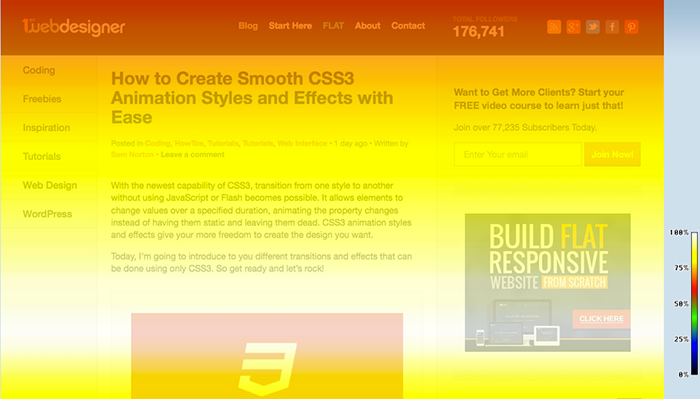
Its natural for the percentage to decline asyou scroll down, but you might seethat it declines at certain sections in the middle of the content.
This is a clear indication that something on your page didnt interest your readers.
For example, if I looked at a heatmap for this post and saw that theres a huge drop off withinthis section, I could conclude that my readers dont like reading about heatmap tools (or potentially about psychographics).
Similarly, hot spots lower down the page indicate that youve touched upon something that excites them.
Record this information forall your content, and youll start seeing patterns in the type of content,the tone, and the formatyour readerslike.
To get even more insight into your readers preferences, you can use click heatmaps, which show you what readers clicked on:

Youll see that certain things attract their attention more than others. Again, look for patterns.
7. Buzzsumos Top Content Tool
The heatmaps can give you a lot of insight into what excites and bores your readers.
However, sometimes you need more, or you dont have enough readers to use heatmaps yet.
Thats where Buzzsumos top content tool comes in.
Youll want to make a list of keywords youll be using within your content. Then, search them one by one in the tool:

The tool will return a list of the most popular content in the past year (sorted by total shares).
Visit as many of these pagesas you can, and record down the answers to these questions in your spreadsheet:
- What format does the content use? (lots of images? videos? big font? small font?)
- What tone does the content use? (news articles? personal stories? conversational?)
- Why would your reader be so excited about this topic?
You can leave the last one blank for now if you dont know, but come back to it later.
When you have a good understanding of your readers, you should be able to figure out why these top articles would appeal to them more than the average content.
Finally, searchall theanswers to all those questions for patterns.
For example, if a large chunk of the most popular posts are mainly image-based, you know that your readers love images.
Tool type #3 Assemble your data, and make it useful
If youve used every tool up until this point, you have a lot of useful data.
Dont justputit on a spreadsheet and forget about it.
Instead, create reader personas. Itwill help you and your team when you need to be remindedfor whom you are writing.
I created this final section for a single tool because I feel thatalthough it is a small step you need to takeits a very important step.
8. Make My Persona
This tool was created by Hubspot, and its brilliant.
It guides you through a simple process that uses allthe different demographic and psychographic information youve collected with all the other tools.
It also ensures that you dont forget any key part of creating a reader persona, e.g.,putting a real name or face to it:

Once you answer all the questions, the tool will producea well-organized persona summary:

First, you should share this with everyone whohelps you with content.
Next, you should be looking at this before you write any content yourself. Always ask yourself what this person would find valuable and interesting. Print it out, and hang it up if you need to.
Note that you can create multiple personas if thats what the data supports.
Conclusion
This is not a huge list, but every tool on this list can be useful.
The better you understand your readers, the more youll be able to write exactly what they want to see (and value).
I recommend trying at least a few of the tools, but if you really want to get a clear picture of what your readers think and care about, use them all.
If I missed a tool that can help writers understand their audiences, please post it in the comments below, and Ill give it a look.
Live From MarketingSherpa Summit 2016: Humana on the power of iterative testing
Editors note: I would like to extend a heartfelt apology to those of you who experienced difficulties streaming portions of todays special live Web clinic. Were working to identify the problem, determine why it effected some of you but not others and prevent it from happening again in the future. In the meantime, the video replay is now available!
This is Ken Bowen, reporting live from the Bellagio hotel in beautiful Las Vegas for MarketingSherpa Summit 2016. For over a decade, Email Summit has been one of the most exciting weeks of the year for email marketing practitioners.
This year, just when you think youve got it all figured out, weve gone and changed the rules.
Instead of just email, weve expanded our focus to also include content marketing, social media, mobile and data.
As Managing Editor of MarketingExperiments, MarketingSherpas sister site, Ive had the privilege of working closely with all nine presenters on the Digital & Data track over the last several months. These marketing leaders are on the bleeding edge of disciplines like behavioral economics, account based-marketing, audience and demand generation, individualized marketing, customer satisfaction quantification and even data-driven direct mail.
Its been a wild couple of months leading up to the event full of late nights at the office, jamming brainstorming sessions into every break and those crazy evenings where you shoot out of bed at 3:00 a.m. with the perfect slide idea. The exclamation point came yesterday, when a modest flight from our home base in Jacksonville, Florida to Las Vegas managed to turn into a 22-hour Homeric epic that played out like a mix of The Terminal and Home Alone.
And Ive loved every minute of it.
After spending months getting to learn from and know some of the brightest, most forward-thinking minds in digital marketing, when I popped out of bed this morning and saw this view out the window, it felt like Christmas morning in the desert, knowing that we would soon get the chance to share these great case studies and stories with our readers.
We hope to bring you details and video of each presentation in the coming weeks, but for now, lets take a look at how Mike Loveridge, Head of Digital Test and Learn, Humana, and his team leveraged iterative testing and captured big gains.
Iterative Testing
Were trying to change customer perception from were a big bad insurance company thats trying to take your money and deny your claims to we want to be your health partner for life, Mike Loveridge said to the overflow crowd in the Da Vinci ballroom.
Our goal is to improve customers health by 20% by 2020, he added.
One way to shift that perception is by testing your messaging.
[Testing radical redesign] is impractical, Mike said. Testing complete new versus complete old was a nightmare.
Instead, Humana starting testing iteratively, with an end goal of testing the former old funnel versus the complete new funnel, optimized step-by-step, to see if sum of the parts equals the whole. Mike referred to this as Humanas Super Test strategy.
During the presentation, Mike walked us through several of these iterative tests. Were excited to share the full video with you soon, but in the meantime, lets take a look at three of the upper-funnel banner tests that Mike presented.
Test #1: Banner redesign
For this banner test which Mike jokingly referred to as Winter grandma versus Summer Clint Eastwood lookalike the team at Humana wanted to test whether the messaging being used on the rotating banner of its homepage was too complex for customers.
You really have to simplify when you only have six seconds, Mike said.
In addition to the change in imagery, the headline was better tailored to users position in the customer journey (upper funnel), the copy was simplified and the CTA was given more visual punch.
The result?
A 433% increase in clickthrough into Humanas marketing funnel. By serving customers with what they want, when they need it, in an accessible way, banner performance skyrocketed.
Test #2: GEO personalization
In this test, the Humana team tested geo personalization, which serves unique pages, ads, etc. based on user location.
Take a couple, put them in a background thats fairly generic, it could be anywhere in the world, Mike said in reference to the Control tested in this experiment. Then take that couple, and put them in front of the Statue of Liberty or the Golden Gate Bridge.
More specifically, the banner featuring the Golden Gate bridge, as pictured above, was served to site users located in Californias Bay Area. And, as youd expect, the banner featuring the Statue of Liberty was delivered to New York.
The result?
A 31% increase in clickthrough.
But this wasnt the biggest surprise.
Mike and the Humana team found that geo-personalization not only increased clickthrough, but also increased overall conversion through the funnel.
p>Test #3: Banner navigation
For this next banner test, Mike told the audience, we simplified the title, bumped up the font size and made the supporting text even simpler. There was a lot of green on the page, so we made the button plum; it really stood out.
The Humana team also changed the scrolling navigation counter (bottom right corner, above) from plum to grey, so that it wasnt competing for attention with the CTA.
The result?
The Treatment outperformed the Control by 192% in clickthrough to the next step in the funnel.
Providing further clarity to the customer, both visually and via text, resulted in a massive boost in banner performance.
Key Takeaway
Later in the presentation, Mike also shared some deeper funnel tests, and spoke in-depth about the necessity of communicating the value of testing both top-down and bottom-up in order to gain buy-in within an organization.
But if theres one thing that Mike wants marketers to take away, its the sheer power of iterative testing.
Iterative testing gives you more results on a more frequent basis, he said. And theyre easier to understand.
Mike is just one of the 30+ speakers who will have presented by the time the sun sets on MarketingSherpa Summit 2016 tomorrow evening.
To read about (and see) more of these incredible stories from our fellow marketers, stay tuned here at MarketingExperiments, and also at our sister site MarketingSherpa.
In the meantime, its been an honor getting to meet so many of you here in Las Vegas and to hear about your own customer-first marketing success stories.
You might also like
Email Marketing: Preheader testing generates 30% higher newsletter open rate for trade journal
3 Takeaways from the MECLABS Live Optimization Webinar
Value Prop: Three Super Bowl commercials that nailed the Only-Factor








